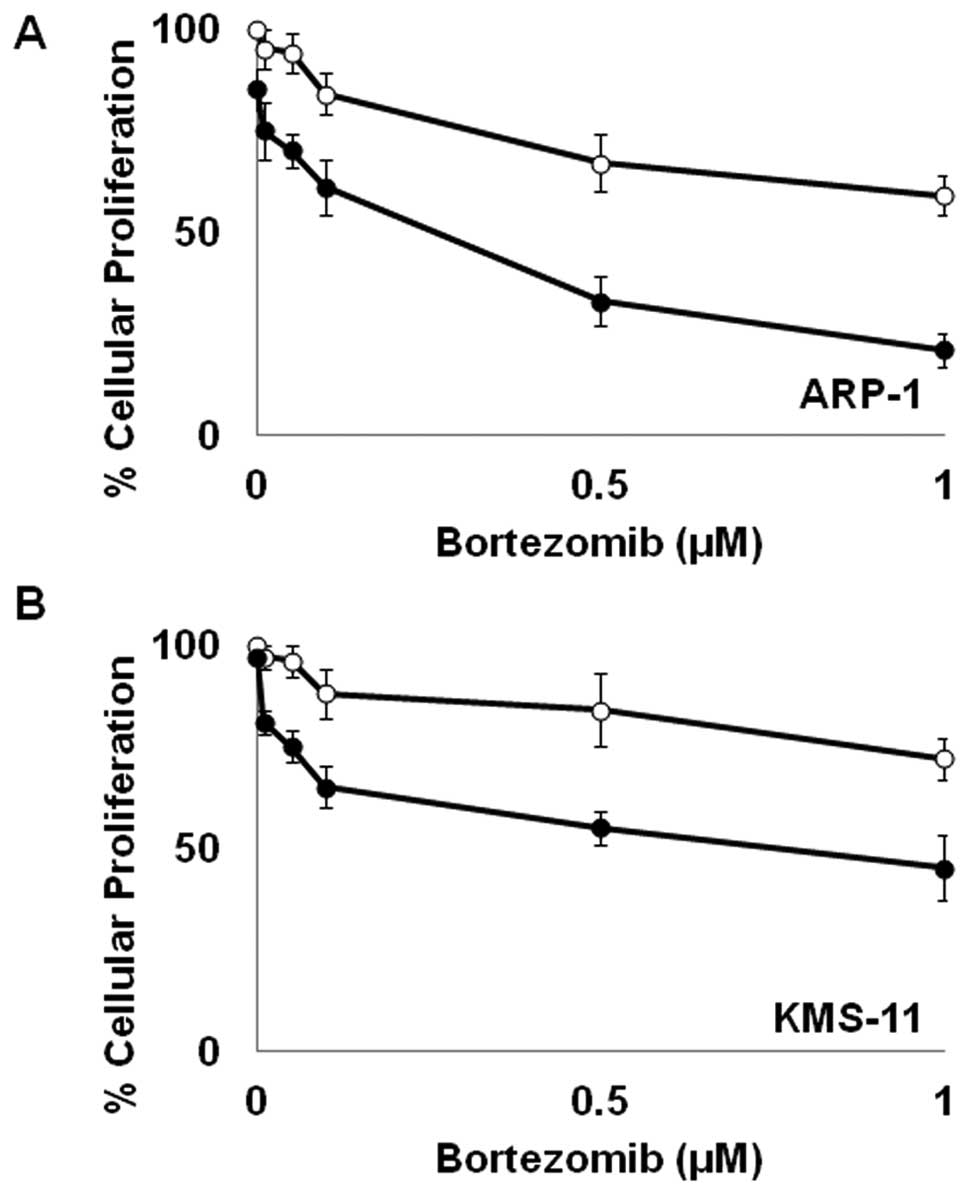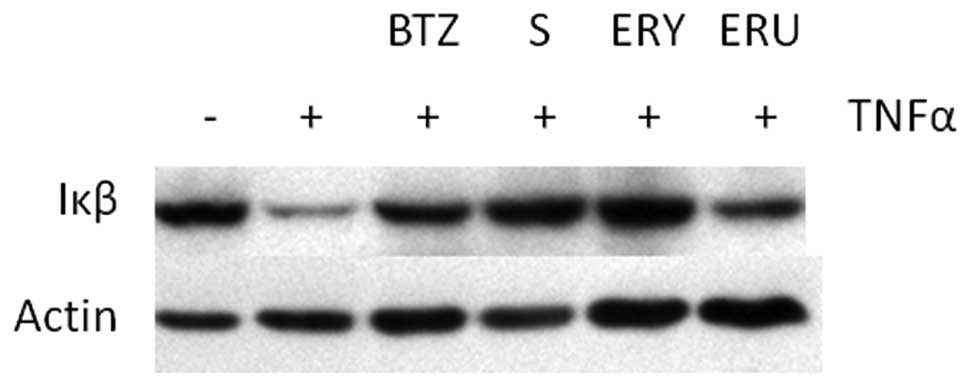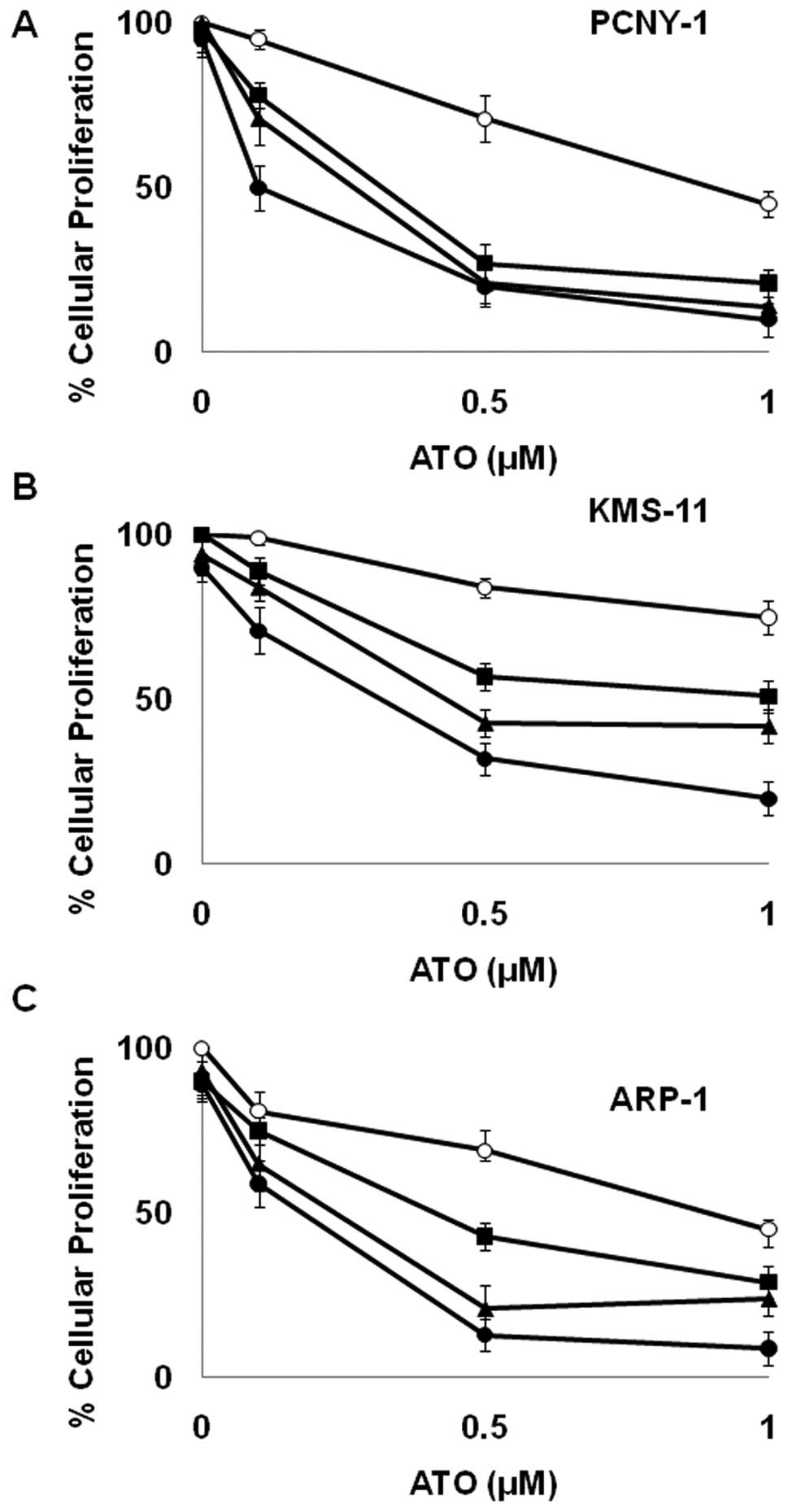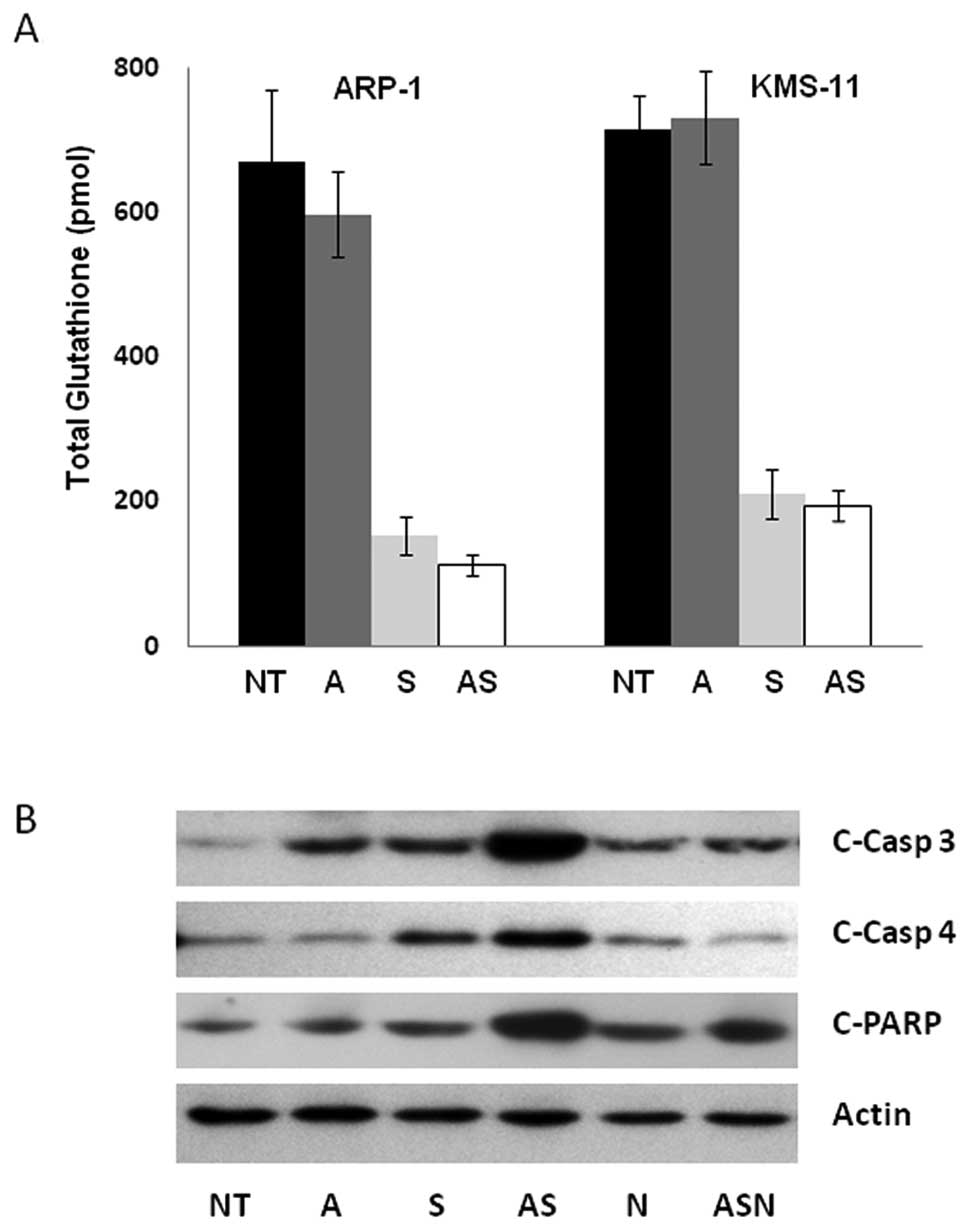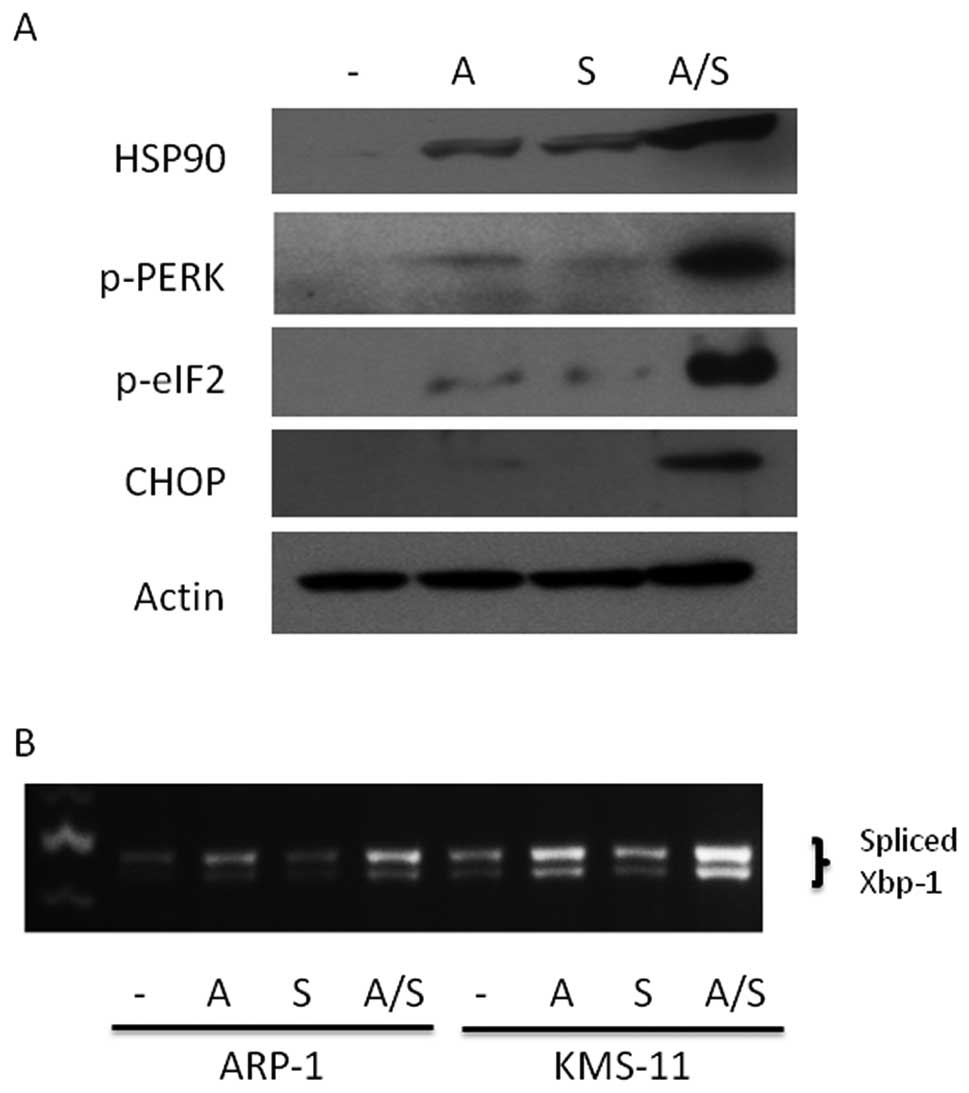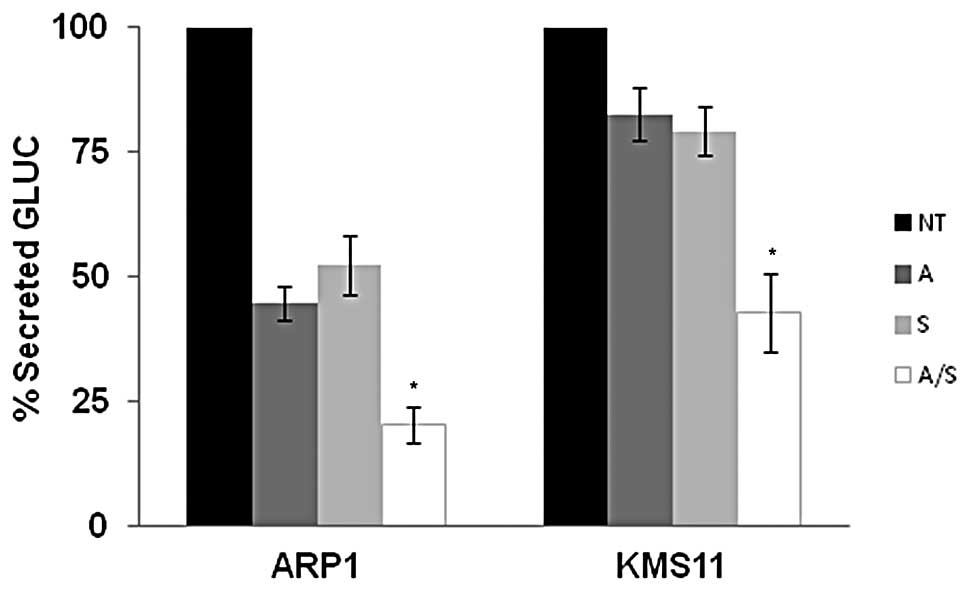|
1
|
Jemal A, Siegel R, Ward E, Hao Y, Xu J and
Thun MJ: Cancer statistics. CA Cancer J Clin. 59:225–249. 2009.
|
|
2
|
Kumar S: Multiple myeloma - current issues
and controversies. Cancer Treat Rev. 36(Suppl 2): S3–S11. 2010.
View Article : Google Scholar : PubMed/NCBI
|
|
3
|
Chari A, Mazumder A and Jagannath S:
Proteasome inhibition and its therapeutic potential in multiple
myeloma. Biologics. 4:273–287. 2010.PubMed/NCBI
|
|
4
|
Cavaletti G: Bortezomib-induced peripheral
neuropathy: facts and genes. Lancet Oncol. 12:120–121. 2011.
View Article : Google Scholar : PubMed/NCBI
|
|
5
|
Lai E, Teodoro T and Volchuk A:
Endoplasmic reticulum stress: signaling the unfolded protein
response. Physiology. 22:193–201. 2007. View Article : Google Scholar : PubMed/NCBI
|
|
6
|
Ron D and Walter P: Signal integration in
the endoplasmic reticulum unfolded protein response. Nat Rev Mol
Cell Biol. 8:519–529. 2007. View
Article : Google Scholar : PubMed/NCBI
|
|
7
|
Calfon M, Zeng H, Urano F, Till JH,
Hubbard SR, Harding HP, Clark S and Ron D: IRE1 couples endoplasmic
reticulum load to secretory capacity by processing the XBP-1 mRNA.
Nature. 415:92–96. 2002. View
Article : Google Scholar : PubMed/NCBI
|
|
8
|
Szegezdi E, Logue SE, Gorman AM and Samali
A: Mediators of endoplasmic reticulum stress-induced apoptosis.
EMBO Rep. 7:880–885. 2006. View Article : Google Scholar : PubMed/NCBI
|
|
9
|
Redman BG, Flaherty L, Chou TH, al-Katib
A, Kraut M, Martino S, Chen B, Kaplan J and Valdivieso M: A phase I
trial of recombinant interleukin-2 combined with recombinant
interferon-gamma in patients with cancer. J Clin Oncol.
8:1269–1276. 1990.PubMed/NCBI
|
|
10
|
Funato T, Ishii T, Kanbe M, Scanlon KJ and
Sasaki T: Reversal of cisplatin resistance in vivo by an anti-fos
ribozyme. In Vivo. 11:217–220. 1997.PubMed/NCBI
|
|
11
|
Munshi NC: Arsenic trioxide: an emerging
therapy for multiple myeloma. Oncologist. 6(Suppl 2): S17–S21.
2001. View Article : Google Scholar : PubMed/NCBI
|
|
12
|
Rousselot P, Larghero J, Labaume S, Poupon
J, Chopin M, Dosquet C, Marolleau JP, Janin A, Brouet JC and
Fermand JP: Arsenic trioxide is effective in the treatment of
multiple myeloma in SCID mice. Eur J Haematol. 72:166–171. 2004.
View Article : Google Scholar : PubMed/NCBI
|
|
13
|
Munshi NC, Tricot G, Desikan R, Badros A,
Zangari M, Toor A, Morris C, Anaissie E and Barlogie B: Clinical
activity of arsenic trioxide for the treatment of multiple myeloma.
Leukemia. 16:1835–1837. 2002. View Article : Google Scholar : PubMed/NCBI
|
|
14
|
Binet F, Chiasson S and Girard D: Arsenic
trioxide induces endoplasmic reticulum stress-related events in
neutrophils. Int Immunopharmacol. 10:508–512. 2010. View Article : Google Scholar : PubMed/NCBI
|
|
15
|
Zhang H, Duncan G, Wang L, Liu P, Cui H,
Reddan JR, Yang BF and Wormstone IM: Arsenic trioxide initiates ER
stress responses, perturbs calcium signalling and promotes
apoptosis in human lens epithelial cells. Exp Eye Res. 85:825–835.
2007. View Article : Google Scholar
|
|
16
|
Tang CH, Chiu YC, Huang CF, Chen YW and
Chen PC: Arsenic induces cell apoptosis in cultured osteoblasts
through endoplasmic reticulum stress. Toxicol Appl Pharmacol.
241:173–181. 2009. View Article : Google Scholar : PubMed/NCBI
|
|
17
|
Brooks JD, Paton VG and Vidanes G: Potent
induction of phase 2 enzymes in human prostate cells by
sulforaphane. Cancer Epidemiol Biomarkers Prev. 10:949–954.
2001.PubMed/NCBI
|
|
18
|
Gamet-Payrastre L, Li P, Lumeau S, Cassar
G, Dupont MA, Chevolleau S, Gasc N, Tulliez J and Terce F:
Sulforaphane, a naturally occurring isothiocyanate, induces cell
cycle arrest and apoptosis in HT29 human colon cancer cells. Cancer
Res. 60:1426–1433. 2000.PubMed/NCBI
|
|
19
|
Fimognari C, Nusse M, Cesari R, Iori R,
Cantelli-Forti G and Hrelia P: Growth inhibition, cell-cycle arrest
and apoptosis in human T-cell leukemia by the isothiocyanate
sulforaphane. Carcinogenesis. 23:581–586. 2002. View Article : Google Scholar : PubMed/NCBI
|
|
20
|
Balasubramanain S, Chew YC and Eckert RL:
Sulforaphane sup-presses polycomb group protein level via a
proteasome-dependent mechanism in skin cancer cells. Mol Pharmacol.
80:870–878. 2011. View Article : Google Scholar : PubMed/NCBI
|
|
21
|
Mi L, Gan N and Chung FL: Isothiocyanates
inhibit proteasome activity and proliferation of multiple myeloma
cells. Carcinogenesis. 32:216–223. 2011. View Article : Google Scholar : PubMed/NCBI
|
|
22
|
Doudican NA, Bowling B and Orlow SJ:
Enhancement of arsenic trioxide cytotoxicity by dietary
isothiocyanates in human leukemic cells via a reactive oxygen
species-dependent mechanism. Leuk Res. 34:229–234. 2010. View Article : Google Scholar
|
|
23
|
Yan H, Wang YC, Li D, Wang Y, Liu W, Wu YL
and Chen GQ: Arsenic trioxide and proteasome inhibitor bortezomib
synergistically induce apoptosis in leukemic cells: the role of
protein kinase Cdelta. Leukemia. 21:1488–1495. 2007. View Article : Google Scholar : PubMed/NCBI
|
|
24
|
Doudican N, Rodriguez A, Osman I and Orlow
SJ: Mebendazole induces apoptosis via Bcl-2 inactivation in
chemoresistant melanoma cells. Mol Cancer Res. 6:1308–1315. 2008.
View Article : Google Scholar : PubMed/NCBI
|
|
25
|
Canestraro M, Galimberti S, Savli H,
Palumbo GA, Tibullo D, Nagy B, Guerrini F, Piaggi S, Cine N,
Metelli MR and Petrini M: Synergistic antiproliferative effect of
arsenic trioxide combined with bortezomib in HL60 cell line and
primary blasts from patients affected by myeloproliferative
disorders. Cancer Genet Cytogenet. 199:110–120. 2010. View Article : Google Scholar
|
|
26
|
Chou TC and Talaly P: A simple generalized
equation for the analysis of multiple inhibitions of
Michaelis-Menten kinetic systems. J Biol Chem. 252:6438–6442.
1977.PubMed/NCBI
|
|
27
|
Chou TC and Talaly P: Analysis of combined
drug effects: a new look at a very old problem. Trends Pharmacol
Sci. 4:450–454. 1983. View Article : Google Scholar
|
|
28
|
Lin JH, Li H, Yasumura D, Cohen HR, Zhang
C, Panning B, Shokat KM, Lavail MM and Walter P: IRE1 signaling
affects cell fate during the unfolded protein response. Science.
318:944–949. 2007. View Article : Google Scholar : PubMed/NCBI
|
|
29
|
Manga P, Bis S, Knoll K, Perez B and Orlow
SJ: The unfolded protein response in melanocytes: activation in
response to chemical stressors of the endoplasmic reticulum and
tyrosinase misfolding. Pigment Cell Melanoma Res. 23:627–634. 2010.
View Article : Google Scholar : PubMed/NCBI
|
|
30
|
Feinman R, Siegel DS and Berenson J:
Regulation of NF-κB in multiple myeloma: therapeutic implications.
Clin Adv Hematol Oncol. 2:162–166. 2004.
|
|
31
|
Maniatis T: A ubiquitin ligase complex
essential for the NF-kappaB, Wnt/Wingless, and Hedgehog signaling
pathways. Genes Dev. 13:505–510. 1999. View Article : Google Scholar : PubMed/NCBI
|
|
32
|
Greenstein S, Krett NL, Kurosawa Y, Ma C,
Chauhan D, Hideshima T, Anderson KC and Rosen ST: Characterization
of the MM. 1 human multiple myeloma (MM) cell lines: a model system
to elucidate the characteristics, behavior, and signaling of
steroid-sensitive and -resistant MM cells. Exp Hematol. 31:271–282.
2003. View Article : Google Scholar : PubMed/NCBI
|
|
33
|
Marcu MG, Doyle M, Bertolotti A, Ron D,
Hendershot L and Neckers L: Heat shock protein 90 modulates the
unfolded protein response by stabilizing IRE1alpha. Mol Cell Biol.
22:8506–8513. 2002. View Article : Google Scholar : PubMed/NCBI
|
|
34
|
Zhang K and Kaufman RJ: The unfolded
protein response: a stress signaling pathway critical for health
and disease. Neurology. 66:S102–S109. 2006. View Article : Google Scholar : PubMed/NCBI
|
|
35
|
Badr CE, Hewett JW, Breakefield XO and
Tannous BA: A highly sensitive assay for monitoring the secretory
pathway and ER stress. PLoS One. 2:e5712007. View Article : Google Scholar : PubMed/NCBI
|
|
36
|
Wen J, Feng Y, Huang W, Chen H, Liao B,
Rice L, Preti HA, Kamble RT, Zu Y, Ballon DJ and Chang CC: Enhanced
antimyeloma cytotoxicity by the combination of arsenic trioxide and
bortezomib is further potentiated by p38 MAPK inhibition. Leuk Res.
34:85–92. 2010. View Article : Google Scholar : PubMed/NCBI
|
|
37
|
Campbell RA, Sanchez E, Steinberg JA,
Baritaki S, Gordon M, Wang C, Shalitin D, Chen H, Pang S, Bonavida
B, Said J and Berenson JR: Antimyeloma effects of arsenic trioxide
are enhanced by melphalan, bortezomib and ascorbic acid. Br J
Haematol. 138:467–478. 2007. View Article : Google Scholar : PubMed/NCBI
|
|
38
|
Berenson JR, Matous J, Swift RA, Mapes R,
Morrison B and Yeh HS: A phase I/II study of arsenic
trioxide/bortezomib/ascorbic acid combination therapy for the
treatment of relapsed or refractory multiple myeloma. Clin Cancer
Res. 13:1762–1768. 2007. View Article : Google Scholar : PubMed/NCBI
|
|
39
|
Qi X and Mochly-Rosen D: The PKCdelta-Abl
complex communicates ER stress to the mitochondria - an essential
step in subsequent apoptosis. J Cell Sci. 121:804–813. 2008.
View Article : Google Scholar : PubMed/NCBI
|
|
40
|
Hung JH, Su IJ, Lei HY, Wang HC, Lin WC,
Chang WT, Huang W, Chang WC, Chang YS, Chen CC and Lai MD:
Endoplasmic reticulum stress stimulates the expression of
cyclooxygenase-2 through activation of NF-kappaB and pp38
mitogen-activated protein kinase. J Biol Chem. 279:46384–46392.
2004. View Article : Google Scholar : PubMed/NCBI
|
|
41
|
Hayashi T, Saito A, Okuno S, Ferrand-Drake
M, Dodd RL and Chan PH: Damage to the endoplasmic reticulum and
activation of apoptotic machinery by oxidative stress in ischemic
neurons. J Cereb Blood Flow Metab. 25:41–53. 2005. View Article : Google Scholar : PubMed/NCBI
|
|
42
|
Walter L and Hajnoczky G: Mitochondria and
endoplasmic reticulum: the lethal interorganelle cross-talk. J
Bioenerg Biomembr. 37:191–206. 2005. View Article : Google Scholar : PubMed/NCBI
|
|
43
|
Brewster JL, Linseman DA, Bouchard RJ,
Loucks FA, Precht TA, Esch EA and Heidenreich KA: Endoplasmic
reticulum stress and trophic factor withdrawal activate distinct
signaling cascades that induce glycogen synthase kinase-3 beta and
a caspase-9-dependent apoptosis in cerebellar granule neurons. Mol
Cell Neurosci. 32:242–253. 2006. View Article : Google Scholar
|
|
44
|
Kuhn DJ, Chen Q, Voorhees PM, Strader JS,
Shenk KD, Sun CM, Demo SD, Bennett MK, van Leeuwen FW, Chanan-Khan
AA and Orlowski RZ: Potent activity of carfilzomib, a novel,
irreversible inhibitor of the ubiquitin-proteasome pathway, against
preclinical models of multiple myeloma. Blood. 110:3281–3290. 2007.
View Article : Google Scholar : PubMed/NCBI
|
|
45
|
Mitsiades CS, Mitsiades NS, McMullan CJ,
Poulaki V, Kung AL, Davies FE, Morgan G, Akiyama M, Shringarpure R,
Munshi NC, Richardson PG, Hideshima T, Chauhan D, Gu X, Bailey C,
Joseph M, Libermann TA, Rosen NS and Anderson KC: Antimyeloma
activity of heat shock protein-90 inhibition. Blood. 107:1092–1100.
2006. View Article : Google Scholar : PubMed/NCBI
|
|
46
|
Shah JJ and Orlowski RZ: Proteasome
inhibitors in the treatment of multiple myeloma. Leukemia.
23:1964–1979. 2009. View Article : Google Scholar : PubMed/NCBI
|
|
47
|
Ye L, Dinkova-Kostova AT, Wade KL, Zhang
Y, Shapiro TA and Talalay P: Quantitative determination of
dithiocarbamates in human plasma, serum, erythrocytes and urine:
pharmacokinetics of broccoli sprout isothiocyanates in humans. Clin
Chim Acta. 316:43–53. 2002. View Article : Google Scholar
|
|
48
|
Miller WH Jr, Schipper HM, Lee JS, Singer
J and Waxman S: Mechanisms of action of arsenic trioxide. Cancer
Res. 62:3893–3903. 2002.PubMed/NCBI
|















